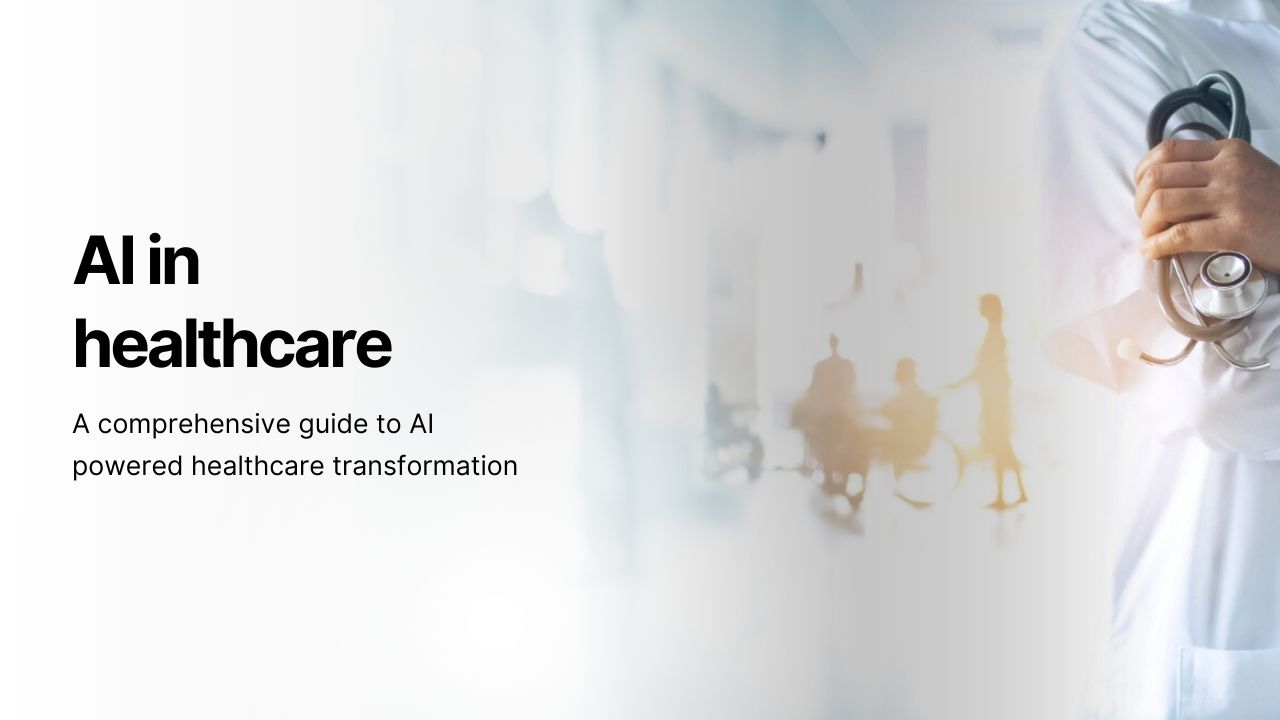After years of anticipation, AI in healthcare is no longer a pilot or tech demo; it is lively, scalable, and delivers measurable results. Hospitals, clinics, and health systems worldwide are embracing agentic AI to enhance patient care, reduce clinician burnout, optimize workflows, and drive financial returns.
Traditionally, healthcare lagged in digital adoption due to regulation, legacy IT, and patient safety concerns. But a stressed clinical workforce and infrastructure mean AI is now a necessity, not a choice.
AI agents represent the next generation of artificial intelligence: autonomous systems that act, not just advise. From generating clinical notes and reviewing billing codes to remote patient monitoring, they are becoming trusted digital colleagues.
This guide explores why 2025 is the breakthrough year for healthcare AI, what AI agents mean in practice, the benefits and use cases across departments, and the challenges hospitals must overcome to unlock their full potential.
In this comprehensive guide, we’ll explore:
- Why AI in healthcare is reaching maturity in 2025
- How AI is transforming radiology, cardiology, oncology, ophthalmology, pathology, and emergency medicine
- The biggest challenges and barriers holding adoption back
- Real-world use cases of AI agents in hospitals
- Implementation strategies and leading vendors
- What’s next: the future of healthcare AI beyond 2025
AI in healthcare: Why 2025 is a turning point
For years, healthcare has faced the same challenges: clinician shortages, inefficient workflows, and rising demand from aging populations. Technology promised solutions, but adoption lagged, AI included, due to fragmented data, clinician distrust, and unclear regulations.
2025 changes the equation. Science, infrastructure, and governance have matured enough to shift AI from promise to practice.
Why now?
- Data explosion: By 2025, healthcare data doubles every 73 days—from EHRs, imaging, genomics, and wearables.
- Computing power: Cloud-native GPUs process multimodal data in minutes, not days.
- Mature AI models: Generative and multimodal AI now draft notes, personalize care, and synthesize insights.
- Regulatory clarity: Agencies like the FDA and EMA have established AI frameworks.
- Hospital readiness: Providers are investing in smart hospitals and AI as core infrastructure.
AI agents in healthcare
AI agents are autonomous systems that move beyond suggestion to execution, reasoning, acting, and completing workflows with human oversight.
Capabilities include:
- Recommending treatments and flagging anomalies
- Automating clinical documentation and coding
- Coordinating care across teams
- Remote patient monitoring with real-time alerts
- Handling admin tasks like scheduling or claims
The key shift is independence. Instead of just suggesting ICD-10 codes, for example, an AI agent can generate encounter notes, assign codes, verify billing, and submit claims, all autonomously.
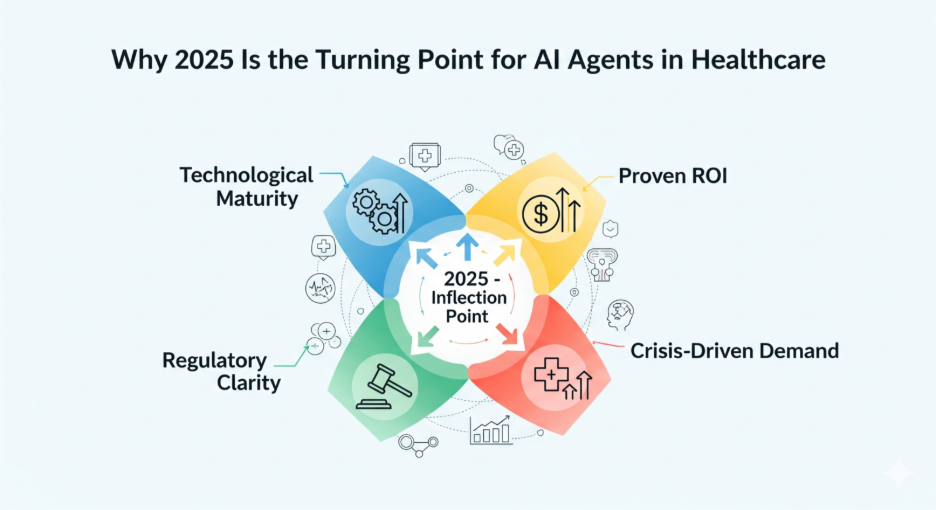
From hype to reality: why AI in healthcare is finally possible today?
AI in healthcare has been around for years, but early attempts disappointed. Systems lacked accuracy, created more work for doctors, and often failed during integration.
What’s changed now?
- Multimodal reasoning. AI can process not just text but also imaging, signals, labs, and patient history together for richer insights.
- Clinically validated large language models (LLMs). Trained on real-world medical data, these models meet safety and compliance standards that earlier algorithms couldn’t.
- Workflow integration. AI is no longer a siloed tool; it can execute tasks inside existing hospital systems.
- Guardrails and safety. Hospitals can now rely on AI that respects compliance frameworks and patient safety requirements.
The evolution of AI in healthcare: what has changed and what still holds us back?
AI’s trajectory in healthcare can be divided into three phases:
1. Automation (pre-2015)
Focus: repetitive back-office tasks
- Medical billing, coding, and claims processing.
- Early rule-based clinical decision support tools.
- Limited impact on direct patient care.
2. Assisted Intelligence (2015–2022)
Focus: supporting clinical tasks
- Radiology tools detecting tumors or anomalies.
- Chatbots for patient triage and FAQs.
- NLP engines extract insights from unstructured notes.
- Still siloed and narrow, useful, but not transformative.
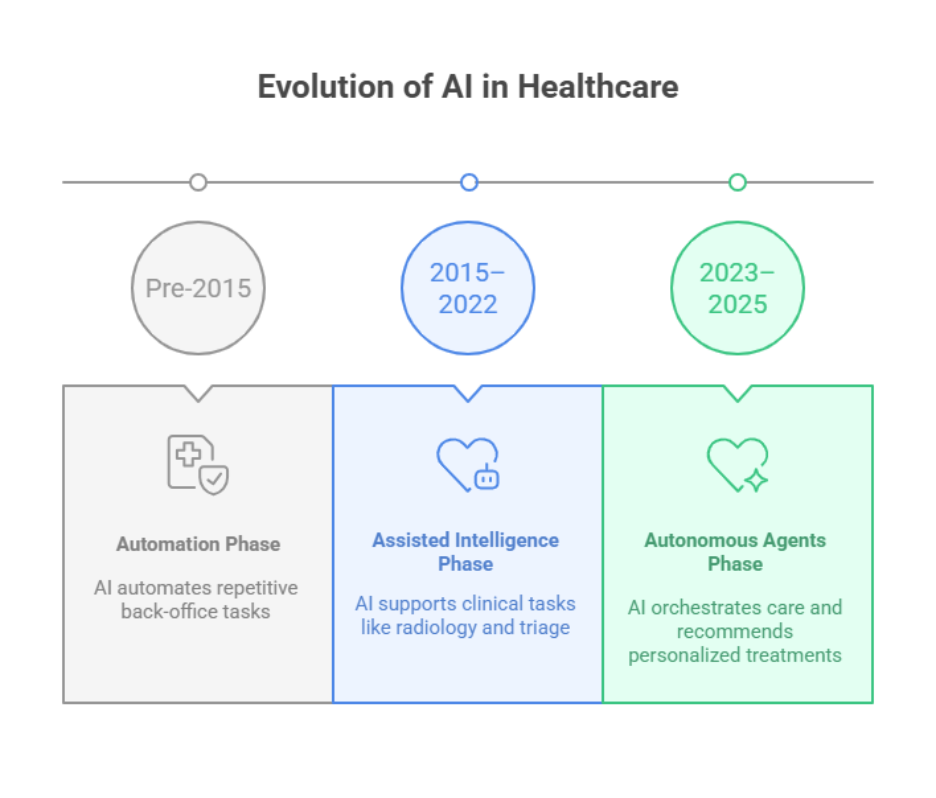
3. Autonomous Agents (2023–2025)
Focus: orchestrating care and recommending next steps
- Sepsis early warning systems are flagging at-risk patients in real time.
- AI scheduling managers optimizing OR and staff rosters.
- Personalized treatment planners recommending drug regimens based on genomics and clinical data.
- AI systems now integrate with EHRs, coordinate with clinicians, and act as proactive agents.
Read our article for a deeper dive into the state of digital transformation and AI in healthcare.
Challenges of AI in healthcare: technical, ethical, and organizational barriers
Before celebrating AI’s benefits, it’s important to address real challenges.
1. Data quality and interoperability
- Healthcare data is often fragmented across EHR systems.
- Missing, mislabeled, or biased data leads to unreliable AI outputs.
2. Bias and fairness
- AI models trained on limited or non-diverse datasets may reflect health inequities.
- Example: dermatology AI trained mostly on lighter skin tones may misdiagnose conditions in darker skin.
3. Trust and explainability
- Clinicians hesitate to rely on “black box” AI without transparency.
- Lack of explainability reduces adoption.
4. Workflow integration hurdles
- If AI adds clicks instead of saving time, adoption drops.
- Many hospitals still lack the IT infrastructure for seamless AI integration.
5. Cost and ROI uncertainty
- AI solutions require significant upfront investment.
- Measuring return on investment (ROI) remains difficult, especially for smaller hospitals.
6. Regulatory ambiguity
- The FDA, HIPAA, and EMA have evolving frameworks, but global standards remain fragmented.
- Hospitals risk compliance issues when deploying untested AI.
7. Workforce resistance
- Some clinicians fear replacement by AI.
- Training and cultural adoption remain big hurdles.
Overcoming these barriers requires a “human-centered AI” approach, keeping clinicians in control, ensuring transparency, and prioritizing patient safety.
For the deeper dive, read our article on challenges for AI in healthcare.
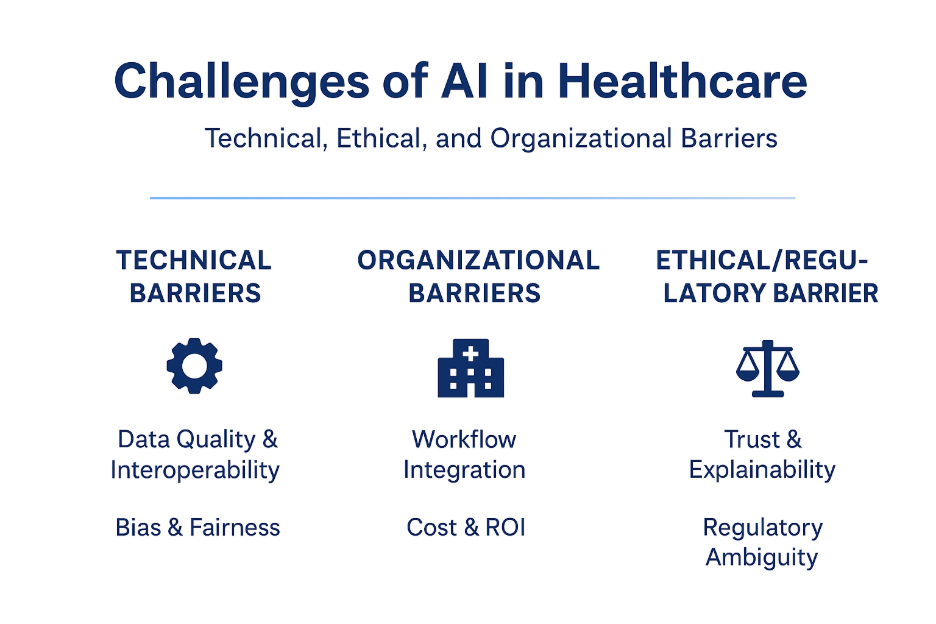
Benefits of AI in healthcare
The adoption of AI in healthcare delivery unlocks a spectrum of benefits:
- Efficiency: Automating repetitive tasks (documentation, coding, scheduling) reduces administrative burden and gives doctors more face time with patients.
- Accuracy: AI enhances diagnostic precision, spotting anomalies in imaging and lab data often missed by humans.
- Access: Virtual care agents extend services to rural or underserved areas, offering 24/7 triage and telehealth support.
- Capacity expansion: AI agents take over routine work, enabling clinicians to focus on complex, high-value care.
- Financial gains: Optimized revenue cycle management, fewer errors, and faster throughput improve margins for hospitals.
For the deeper dive, read our blog on benefits of AI in healthcare.

AI assistants for clinical specialties
AI’s most immediate and visible impact is inside specific hospital departments, where it directly enhances clinical decision-making, reduces doctor workload, and improves outcomes. Below, we explore where AI is making the biggest difference as smart and capable doctors' assistants.
AI in radiology: from image overload to intelligent diagnosis
Radiology is being transformed by AI, which automates image analysis, accelerates diagnosis, and reduces clinician workload. Intelligent agents now support everything from screening to workflow optimization.
Medical image analysis agent
This agent processes CT, MRI, X-ray, and ultrasound images at scale, detecting tumors, fractures, and abnormalities. It reduces radiologist workload by pre-screening studies and prioritizing critical cases.
Cross-sectional imaging assistant
It analyzes CT and MRI scans to detect structural changes, measure organs, and identify pathology. Standardized, quantitative reports improve consistency and accelerate evaluation.
Emergency radiology triage agent
This agent rapidly flags life-threatening conditions like hemorrhage or pulmonary embolism within minutes of image acquisition. It ensures urgent cases get immediate radiologist attention in emergencies.
Radiologic pattern recognition copilot
It identifies subtle imaging patterns and correlates findings across studies to suggest differential diagnoses. Radiologists gain greater accuracy and confidence in complex cases.
Imaging protocol optimization assistant
This agent recommends tailored imaging protocols, contrast use, and radiation settings for each patient. The result is safer scans, better images, and improved diagnostic yield.
Radiology workflow manager
It coordinates imaging schedules, prioritizes cases, and balances workloads across the department. Operations become more efficient, with faster turnaround times and higher productivity.
For a deeper dive, read our blog on AI in radiology.

AI in cardiology: ECG monitoring, heart disease detection, and preventive care
Cardiovascular disease remains the leading cause of death worldwide. AI in cardiology focuses on early detection and prevention.
Automated ECG analysis agent
This AI agent analyzes ECGs to detect arrhythmias, STEMI, AFIB, heart blocks, and ischemic changes. It flags patterns instantly with high accuracy, generating standardized reports for faster clinical decisions.
Cardiac risk stratification AI copilot
This copilot synthesizes demographics, biomarkers, imaging results, and family history to assess cardiovascular risk. It continuously updates predictions and provides evidence-based preventive recommendations.
Echocardiogram interpretation AI assistant
This assistant auto-analyzes 2D/3D echo images to extract cardiac measurements and generate standardized reports. It accelerates interpretation and ensures consistency across cases.
Heart failure monitoring agent
This agent tracks symptoms, vitals, and behavior patterns to predict decompensation in heart failure patients. It builds personalized baselines and alerts doctors to enable proactive care.
Coronary angiography planning copilot
This copilot reviews imaging to suggest catheter paths, wire choices, and stent sizing. It simulates procedures, predicts complications, and optimizes contrast use for better planning.
For a deeper dive, read this blog on AI in cardiology.

AI in oncology: early detection, precision therapy, and outcome prediction
Cancer care is one of the most complex areas of medicine, requiring early detection and tailored therapies.
Cancer staging and prognosis agent
This agent analyzes imaging, pathology reports, and biomarker profiles to determine accurate TNM staging. It integrates molecular markers and generates standardized reports aligned with oncology guidelines.
Chemotherapy dosing copilot
This copilot recommends chemotherapy dosing by tracking pharmacokinetics, organ function, blood counts, and toxicity patterns. It predicts adverse reactions and suggests safe dose modifications in real time.
Treatment response monitoring agent
This agent tracks tumor markers, imaging results, labs, and symptoms across treatment cycles. It detects early signs of response or resistance before they become clinically evident.
Precision oncology advisor
This advisor integrates tumor genomics, pharmacogenomics, and clinical guidelines to recommend targeted therapies. It highlights actionable mutations and predicts drug response patterns for personalized treatment.
Bone marrow transplant matching copilot
This copilot evaluates HLA typing, minor antigens, and compatibility factors to rank donor-recipient matches. It calculates transplant success probabilities and assesses risks like graft-versus-host disease.
Cancer risk assessment assistant
This assistant analyzes genetic markers, family history, environmental exposures, and biomarker data to calculate personalized risk scores. It recommends tailored screening and preventive strategies.
For a deep dive, read our blog on AI in oncology.
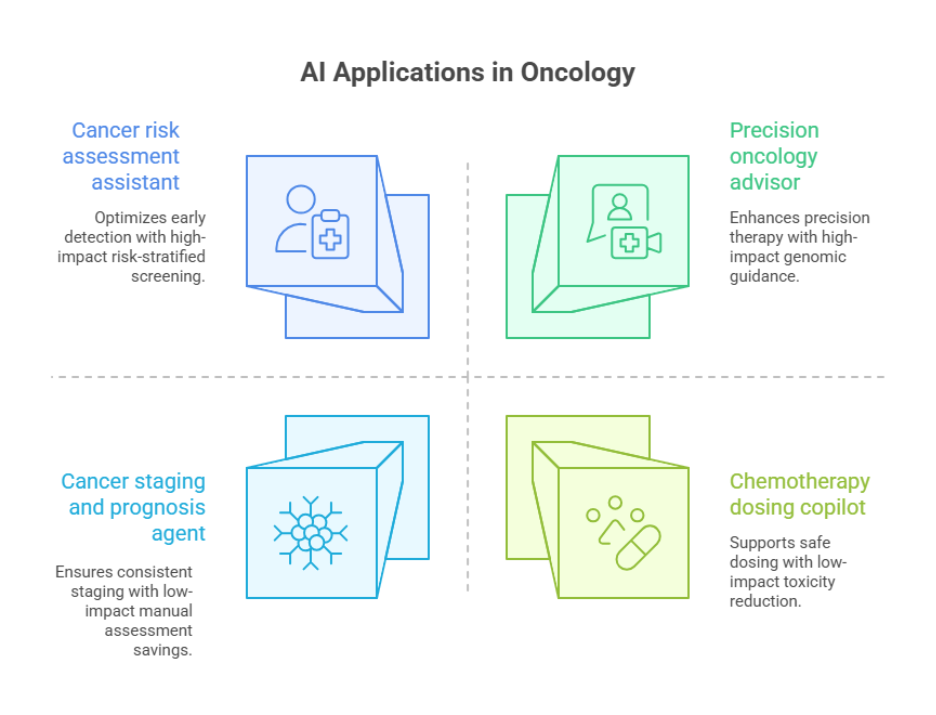
AI in pathology and laboratory medicine: smarter testing and faster reports
AI in pathology and laboratory medicine enables automated specimen analysis, biomarker discovery, and lab result interpretation with high accuracy. It streamlines workflows, reduces errors, and enhances diagnostic precision for faster, consistent patient care.
Digital pathology analysis assistant
This AI assistant performs automated cancer detection in tissue specimens using advanced imaging analysis.
Blood smear analysis assistant
Using AI-driven microscopy, this assistant analyzes digitized blood smears to identify abnormal cell morphology, blasts, dysplasia, and parasites.
Automated lab result interpretation assistant
This AI assistant provides intelligent analysis of complex laboratory panels with clinical correlation and trend analysis.
Laboratory quality control agent
This AI agent continuously monitors analytical processes to detect systematic errors, instrument malfunctions, and quality control failures.
Microbiology identification assistant
This AI in healthcare assistant provides automated pathogen identification and antimicrobial susceptibility testing using advanced pattern recognition algorithms.
Biomarker discovery and validation copilot
This AI copilot integrates genomic, proteomic, and clinical data to identify novel disease biomarkers and validate their diagnostic applications.
For a deep dive, read this blog on AI in pathology and laboratory medicine.
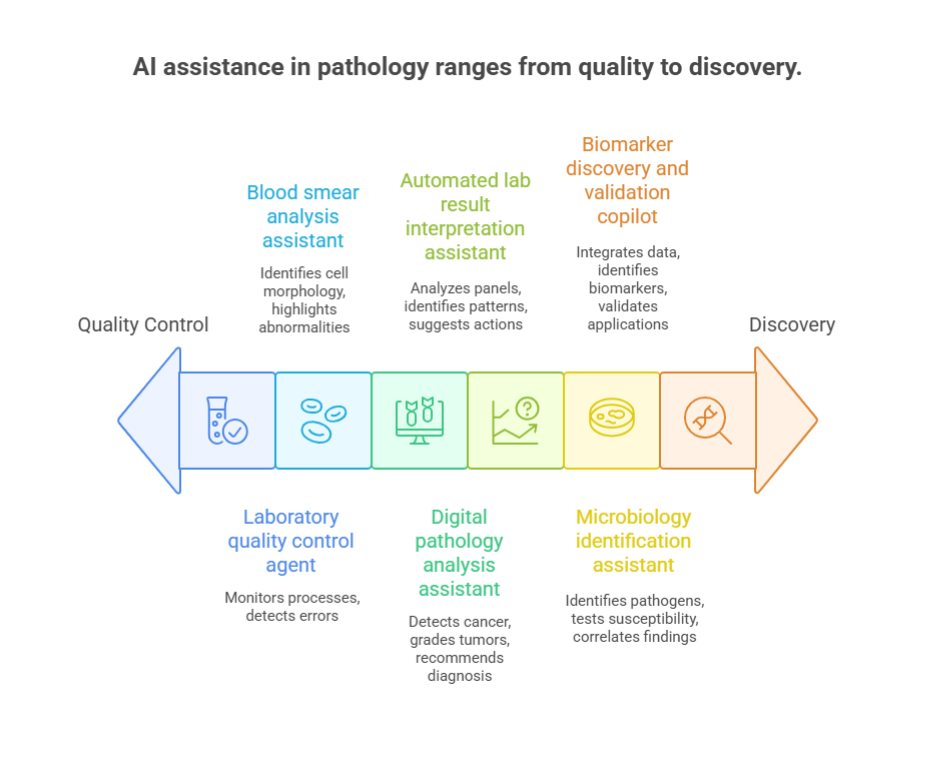
AI in ophthalmology: detecting retinal diseases with accuracy
Ophthalmology has become a major success story for AI. Algorithms can now diagnose eye diseases with specialist-level accuracy.
Diabetic retinopathy screening agent
This AI agent performs automated analysis of retinal photography to detect diabetic eye disease and grade severity levels.
Glaucoma detection and monitoring assistant
This AI assistant analyzes optical coherence tomography (OCT) images and visual field tests to detect glaucoma progression and optic nerve damage.
Age-related macular degeneration tracker
This AI tracker continuously monitors retinal changes associated with AMD using fundus photography and OCT imaging.
Retinal vessel analysis copilot
This AI copilot performs automated analysis of retinal blood vessels to assess cardiovascular health and detect systemic diseases.
Ophthalmic surgery planning assistant
This AI assistant analyzes pre-operative imaging to optimize cataract surgery planning, IOL selection, and refractive surgery outcomes.
Vision rehabilitation optimizer
This AI optimizer creates personalized vision rehabilitation programs for patients with visual impairments.
For a deep dive, read our guide to AI in ophthalmology.
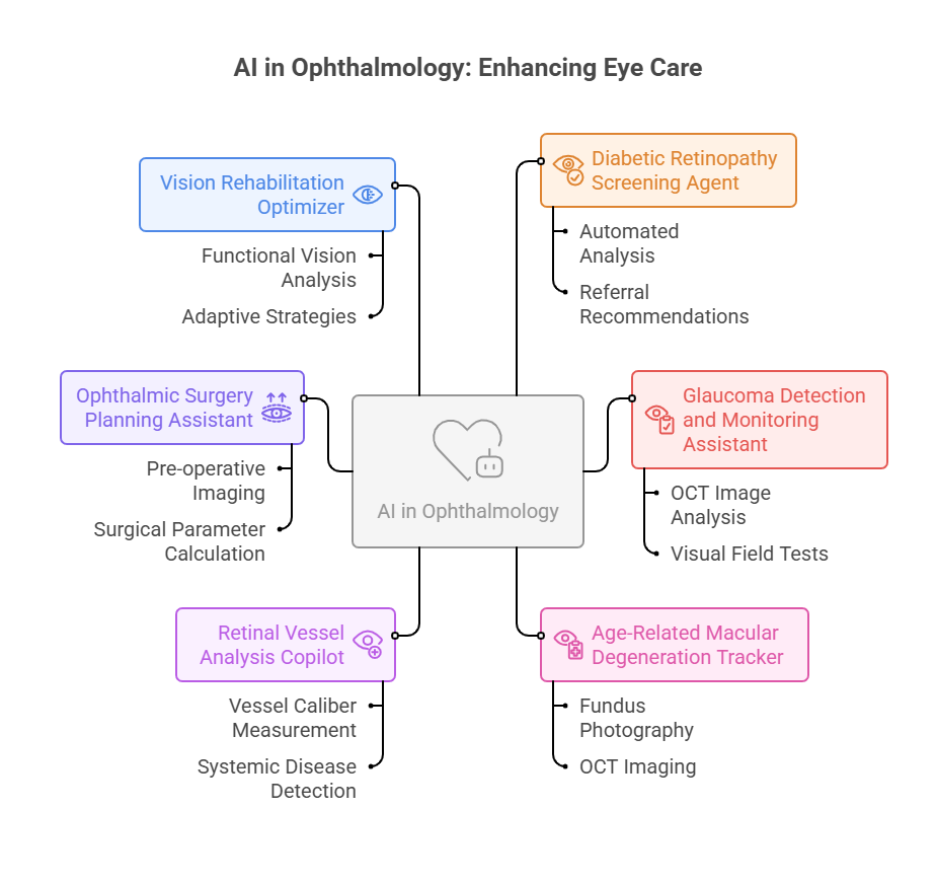
AI in emergency medicine: faster triage and critical care decisions
AI in emergency medicine supports rapid triage, risk prediction, and real-time clinical decision-making. It accelerates critical interventions, optimizes resource allocation, and improves patient survival outcomes in acute care settings.
Triage severity predictor
This AI agent automatically prioritizes patients using vital signs, symptoms, and clinical presentation data.
Sepsis early warning agent
This AI agent continuously monitors vital signs, laboratory values, and clinical indicators to predict sepsis onset before clinical deterioration becomes apparent.
Chest pain risk stratification agent
This AI in healthcare rapidly analyzes chest pain symptoms, ECG findings, and laboratory results to determine cardiac risk levels.
Trauma assessment copilot
This AI copilot provides automated injury scoring and resource allocation recommendations for trauma patients.
Drug overdose identification assistant
This AI agent uses pattern recognition to identify substances causing overdose symptoms from clinical presentation and available testing data.
Emergency procedure guidance assistant
This AI assistant provides real-time step-by-step guidance for emergency procedures, including intubation, central line placement, and resuscitation protocols.
For a deep dive, read this blog on AI in emergency medicine.
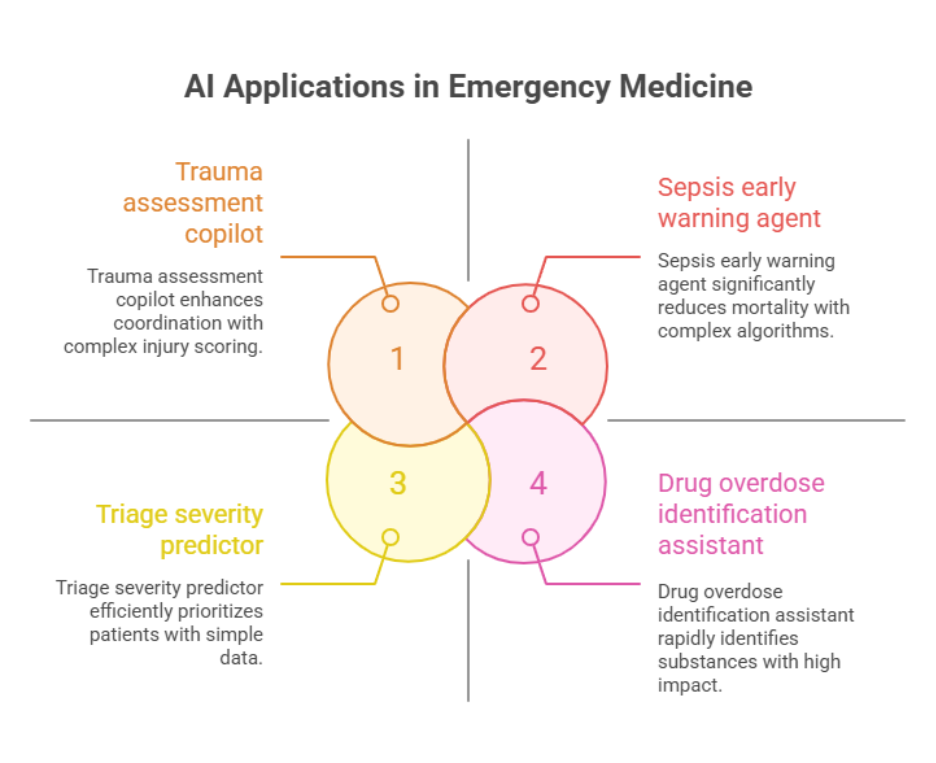
AI in medical imaging: accelerating precision healthcare
AI is transforming medical imaging by improving scan quality, detecting anomalies earlier, and supporting radiologists with faster, more accurate insights. It enhances both patient care and clinical efficiency.
Here’s how AI in medical imaging is already making an impact:
Image enhancement and reconstruction
Noise reduction in MRI and CT scans leads to clearer, more trustworthy results. Super-resolution imaging upgrades older, lower-quality images, giving doctors new insights without needing new scans.
Reconstruction from partial data allows for usable scans even in challenging situations (like patients who can’t hold still).
Anomaly detection and diagnosis
AI identifies tumors, fractures, or early-stage diseases that might otherwise go unnoticed.
Pattern recognition offers another set of “eyes” for radiologists, often picking up on subtle indicators.
Synthetic data generation
AI makes realistic images that train future AI tools, enhancing the accuracy of next-generation solutions, even in rare or complex cases.
Read our in-depth article for more information about AI in medical imaging.
AI in clinical workflows, operations, and key use cases
Beyond medical specialties, AI is fundamentally transforming healthcare workflows and hospital operations, the essential "plumbing" that makes healthcare systems function. The true value of AI agents emerges through their real-world applications, where they're revolutionizing both clinical care and operational efficiency across healthcare organizations.
Clinical documentation: eliminating the admin burden
Doctors currently spend nearly 40% of their time on documentation, cutting into patient care and personal time. AI in healthcare is revolutionizing this process by acting as intelligent digital scribes:
How it works:
- Listening to patient consultations in real-time
- Generating structured clinical notes instantly
- Automatically suggesting accurate ICD-10 codes and billing entries
- Seamlessly syncing data with Electronic Health Record (EHR) systems
- Cross-checking coding accuracy and billing compliance
For a deep dive, read this blog on clinical workflow automation with AI.
Patient triage and virtual care coordination
AI-powered virtual assistants are transforming frontline patient interactions and care coordination:
Capabilities:
- Serving as digital front doors through AI chatbots
- Answering patient queries via chat or voice interfaces
- Guiding symptom reporting and providing intelligent triage
- Delivering pre-visit instructions and medication reminders
- Coordinating complex care pathways between primary care, specialists, and follow-ups
- Scheduling appointments based on urgency and availability
For a deep dive, read this blog on Healthcare AI assistants: Improving patient triage and care coordination.
EHR integration and workflow optimization
AI in healthcare becomes a power assistant when it is seamlessly embedded into existing healthcare IT infrastructure. By 2025, this integration is reaching maturity levels:
Current capabilities:
- Leading EHR providers (Epic, Cerner, Allscripts) now support sophisticated AI plugins
- AI suggests next best actions directly within clinician workflows
- Smart alert systems prevent alert fatigue by highlighting only critical, relevant issues
- Real-time decision support integrated into patient charts
- Automated quality measure tracking and compliance monitoring
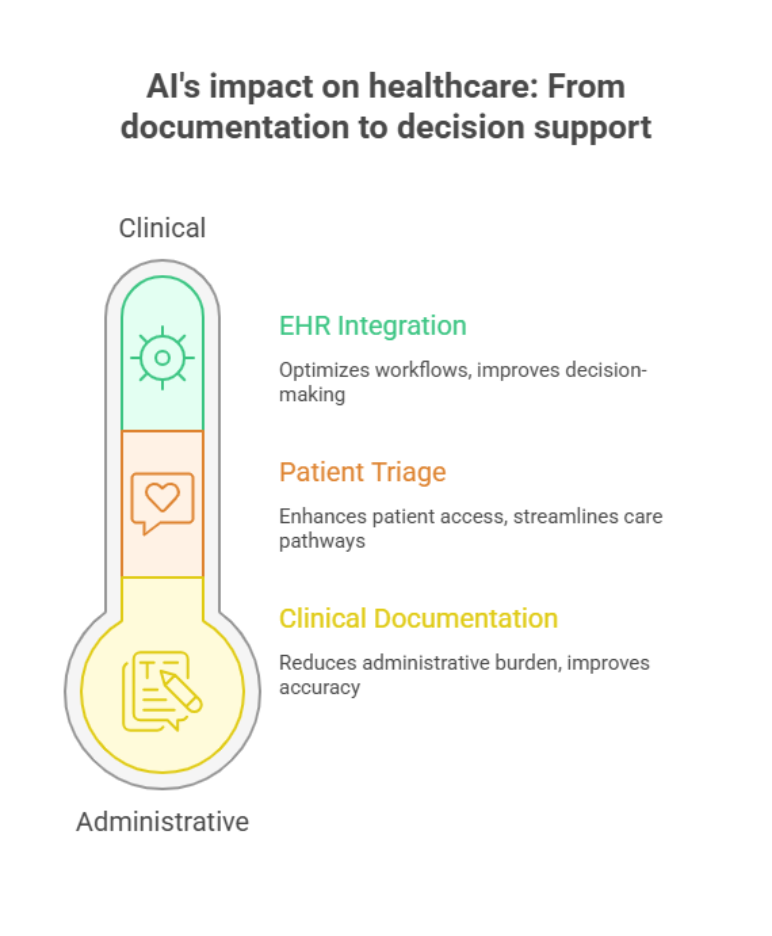
Remote patient monitoring: AI for healthcare beyond hospital walls
Chronic disease management is rapidly shifting from hospital-centric to home-based care models:
Technology stack:
- Wearable devices (Apple Watch, Fitbit, continuous glucose monitors) streaming real-time health data
- IoT-enabled medical devices providing continuous monitoring
- AI agents analyzing vital signs, detecting patterns, and predicting health deterioration
- Automated alert systems triggering preventive interventions
- Integration with clinical teams for seamless care coordination
For more in-depth information, visit this blog on AI for remote patient monitoring.
How to implement AI in hospitals
Artificial Intelligence (AI) is finding its way to the doctors’ offices. But adopting AI in healthcare isn’t just about installing new technology.
You need a clear roadmap for gen AI adoption, prioritized use cases, and the right vendors and partners for implementation and integration.
Importantly, you need to know what not to do to avoid spending time and money on umpteen POCs that never progress to production.
Preventing AI failures in healthcare
The gap between AI POCs and AI in production lies not in the technology itself, but in how it’s architected, trained, and integrated into clinical workflows.
Why do AI failures in healthcare happen?
- Poor data quality: Healthcare data is often unstructured, incomplete, and siloed.
- Limited diversity: Models trained on narrow datasets fail across different populations.
- Black-box models: Lack of explainability erodes clinician trust.
- Workflow misfit: Tools outside clinical workflows get ignored.
- Regulatory gaps: Many systems don’t meet compliance and validation standards.
- Poor use case: Picking use cases that are limited in scope for AI to deliver RoI.
- Poor architecture: The difference between 5 million tokens and 6 million tokens for a workflow could mean the difference between positive RoI and flushing money down the drain.
For a deep dive, read this blog on preventing AI failures in healthcare.
Implementation roadmap for healthcare AI
Strategic planning lays the foundation for implementing AI in healthcare successfully. It ensures hospitals are technologically, financially, and culturally ready before moving into pilots and full-scale deployment.
In our experience, starting with a readiness assessment must be the first step. Hospitals must assess their technical infrastructure, financial capacity, organizational culture, regulatory compliance, and clinical workflows to determine their readiness for adopting AI, ensuring that systems, budgets, staff, and processes can support and sustain the technology effectively.
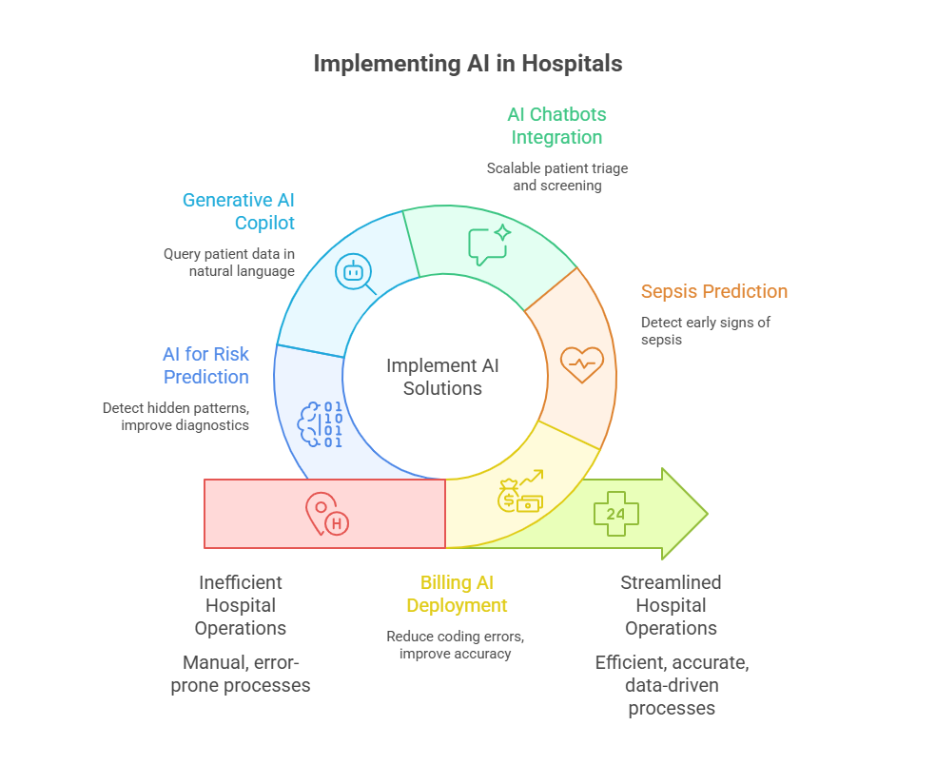
After that, build a roadmap for agile AI build and adoption that is co-designed and tested along with doctors and nurses.
Lastly, have a clear RoI assessment framework to test and document results for the leadership and board.
For a deeper dive into best practices and methodologies, read our guide on implementing AI in healthcare.
How smart hospitals implement AI: case studies
Hospitals across the globe are proving that well-implemented AI creates measurable impact:
Mayo Clinic: Driving efficiency with billing AI
Mayo Clinic deployed AI agents to review patient charts before billing. This reduced coding errors, improved claim accuracy, and minimized revenue leakage. The result? A 5:1 ROI, for every dollar invested, the hospital saved five. Beyond financial returns, it eased the administrative burden on staff, allowing more focus on patient care.
Mount Sinai: Predicting sepsis before symptoms
Mount Sinai uses AI to analyze patient vitals, lab results, and historical records to detect early signs of sepsis, often hours before clinical symptoms appear. This life-saving intervention has drastically improved ICU outcomes and reduced mortality rates.
Apollo Hospitals (India): Scalable patient triage with AI chatbots
Apollo Hospitals, serving millions of patients annually, integrated AI chatbots for first-level triage. These virtual assistants manage appointment scheduling, symptom screening, and routing patients to the right specialty. This freed up hospital staff while ensuring faster, more accurate care delivery across India’s vast population.
Max Healthcare: Longitudinal data analysis
Max Healthcare partnered with GoML to deploy a generative AI copilot powered by Claude 3.5 on AWS Bedrock. The system allows doctors to query longitudinal patient data in natural language, analyze diagnosis trends, and track patient journeys in real time. This reduced reliance on engineering teams, accelerated decision-making, and enabled proactive, data-driven care delivery
Atria: Risk prediction with AI
Atria Healthcare partnered with GoML to unify patient data and deploy generative AI for risk prediction. The AI-powered system detects hidden patterns, connects symptoms with patient history, and delivers real-time insights through intuitive dashboards. This transformed care from reactive to predictive, improving diagnostic accuracy, speeding up data access, and boosting risk prediction by 50%.
Top healthcare AI companies in 2025
Now that you know how to implement AI in your healthcare environment, you have a key decision to make.
Buy or build?
In our experience, the answer is a combination of both. There is no off-the-shelf software that will magically transform your operations. But there are robust solutions and platforms that give you the foundation for large scale AI implementation.
The healthcare AI ecosystem is rapidly evolving. As of 2025, some of the most interesting healthcare solution providers include:
- GoML: A leading AI development company with 120+ gen AI specialists building custom healthcare AI solutions, including clinical decision support systems, patient risk prediction models, and AI-powered diagnostic tools for major healthcare providers.
- Tempus: Pioneering AI in oncology and genomics, enabling personalized cancer treatment through deep molecular insights.
- Butterfly Network: Democratizing access to imaging with AI-powered handheld ultrasound devices, making diagnostics portable and affordable.
- PathAI: Transforming digital pathology with AI models that deliver faster, more accurate pathology reads at scale.
- Olive AI: Focused on robotic process automation (RPA) for healthcare, optimizing administrative and back-office workflows.
- Nabla and Nuance (Microsoft): Leading the AI medical scribe market, reducing documentation burdens for doctors and enabling more face-to-face patient time.
For hospitals, knowing who the serious players are helps cut through the noise of hundreds of emerging vendors.
For a deeper dive, see our full list of top healthcare AI companies.
Top healthcare AI implementation companies in 2025
While having powerful AI solutions and platforms is essential, successful deployment requires specialized implementation and system integration expertise. These companies excel at turning AI innovations into real-world clinical results:
- GoML: A leading AI consulting and development company with 120+ gen AI specialists focused on building and integrating production-grade healthcare AI systems. GoML has successfully deployed AI solutions for major healthcare providers like Max Healthcare and Atria, creating secure, scalable platforms for clinical decision-making and patient risk prediction.
- Accenture Health: Leveraging decades of healthcare consulting experience to integrate AI solutions with existing clinical workflows and organizational change management.
- ZS Associates: Specializing in healthcare data analytics and AI implementation, particularly in pharmaceutical and provider settings, with deep expertise in clinical validation and regulatory compliance.
- Deloitte Digital Health: Offering end-to-end AI implementation services from strategy development through deployment and adoption, with strong focus on healthcare-specific regulatory requirements and clinical workflow optimization.
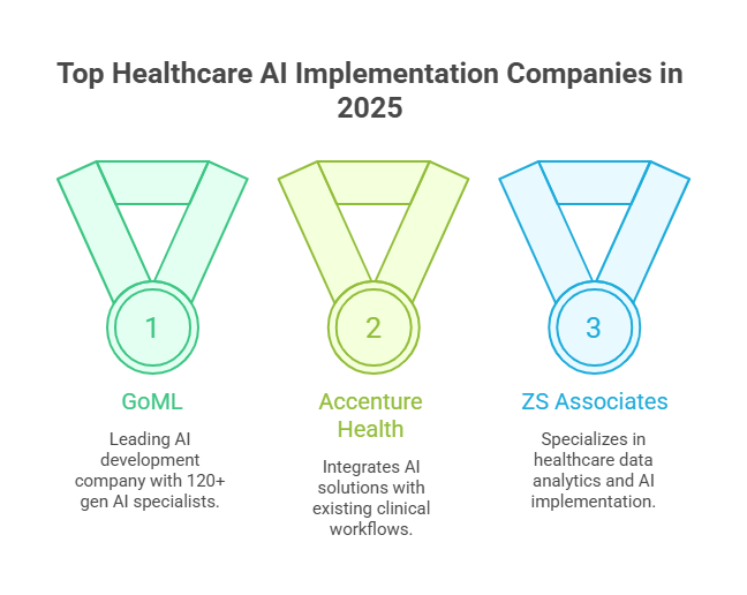
Our list of top AI implementation companies for healthcare will be helpful as you evaluate ways to integrate AI in your operations.
The future of AI in healthcare
Today’s AI agents reduce documentation burdens and accelerate diagnostics, but the next decade will bring far greater impact, predicting disease before symptoms, preventing emergencies, and prescribing personalized interventions.
Trends to watch
- Multimodal AI: Combining imaging, genomics, labs, and patient history into unified insights for precision medicine.
- Federated learning: Training across hospitals without moving sensitive data, enhancing privacy and collaboration.
- Digital hospitals: By 2030, AI will manage diagnostics, scheduling, inventory, and patient flow, freeing clinicians to focus on care.
Predictions for 2035
Experts expect AI to draft most clinical notes, power triage systems, and predict adverse events days ahead of time. Hospitals will achieve operational excellence with AI-driven resource allocation, while doctors focus on patient relationships and clinical judgment.
For a deep dive, read this blog on The future of AI in healthcare: smart hospitals and AI agents in 2026.
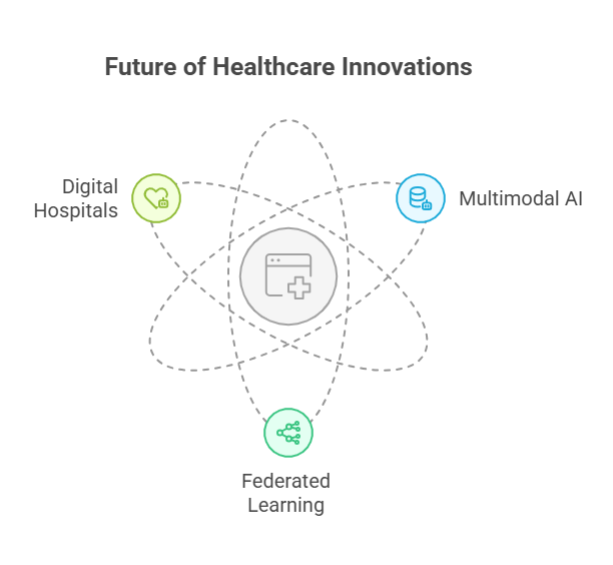
AI in healthcare is no longer just experimental tools; they’re becoming the backbone of modern medicine. From diagnostics to documentation and triage to treatment planning, these intelligent systems are reshaping how care is delivered.
The real opportunity lies not only in adopting AI agents but in doing so strategically, integrating them into workflows, ensuring compliance, and preparing staff for a new era of collaboration between humans and machines. As healthcare moves into 2025 and beyond, one thing is clear: organizations that embrace AI agents today will be tomorrow’s leaders in delivering smarter, faster, and more personalized care.
FAQs
1. How accurate are AI systems for detecting diabetic retinopathy compared to human specialists?
AI systems for retinal disease detection have shown remarkable accuracy, with FDA-approved autonomous diagnostic systems now available for diabetic retinopathy screening. Most of the studies demonstrate that AI can achieve diagnostic performance comparable to or exceeding that of trained ophthalmologists in detecting vision-threatening conditions.
Learn more: AI retinal disease detection case study
2. What specific hospital operations can generative AI streamline beyond clinical documentation?
Generative AI transforms hospital operations through logistics optimization, administrative task automation, medical coding, scheduling improvements, and patient flow management. It can also automate insurance verification, prior authorization processes, and revenue cycle management tasks.
Learn more: Streamlining hospital operations with Generative AI
3. How does AI in healthcare organizations protect patient data?
Healthcare organizations must implement robust data security measures, including encryption, anonymization, access controls, and HIPAA-compliant AI frameworks. Experts recommend using AI for consultation rather than replacement, with intensive oversight and patient-centric approaches.
Learn more: Generative AI revolutionizing healthcare data security
4. What are the most common causes of AI system failures in healthcare settings?
Common AI failures stem from data quality issues, integration challenges with legacy systems, inadequate training data, algorithm bias, and insufficient human oversight. Poor change management and staff resistance also contribute to implementation failures.
Learn more: Preventing AI failures in Healthcare
5. What role does generative AI play in hospital operations?
Generative AI automates administrative workflows such as scheduling, discharge summaries, and patient communication, helping hospitals reduce inefficiencies, cut costs, and free up clinicians to focus on patient care.
Learn more: Healthcare data security
6. Can large language models (LLMs) transform medical data analysis?
Yes. LLMs can process unstructured clinical data, like notes, lab reports, and imaging results, into actionable insights. This accelerates research, supports evidence-based decisions, and unlocks new opportunities in precision medicine.
Learn more: Patient data analysis for Max Healthcare
Want to implement AI agents that transform healthcare delivery in 2025 and beyond?
GoML is a leading Gen AI development company that helps hospitals, health systems, and MedTech innovators deploy AI in hospitals and across care settings faster, securely, and at scale. From clinical documentation automation to diagnostic support, patient triage, and revenue cycle optimization, we deliver enterprise-ready AI agent solutions that improve outcomes, reduce burnout, and drive measurable ROI.
Reach out to us today.
